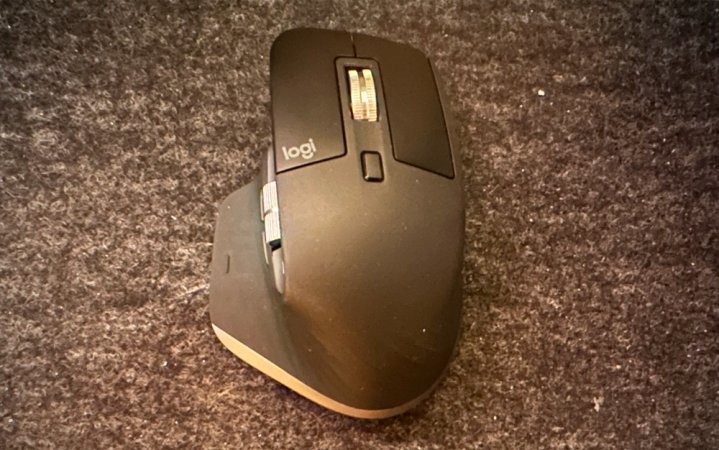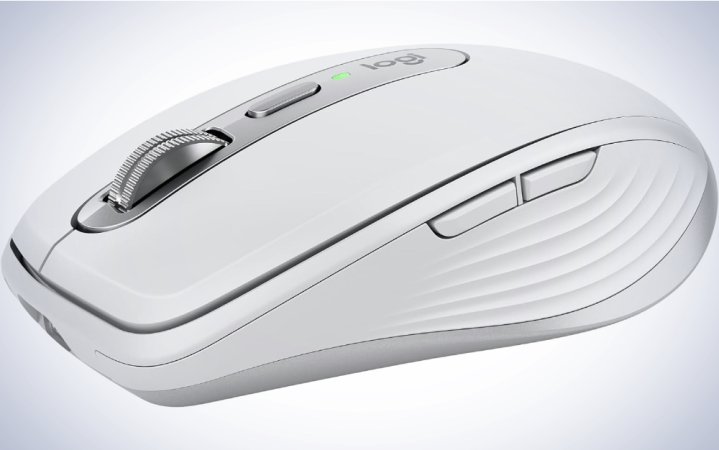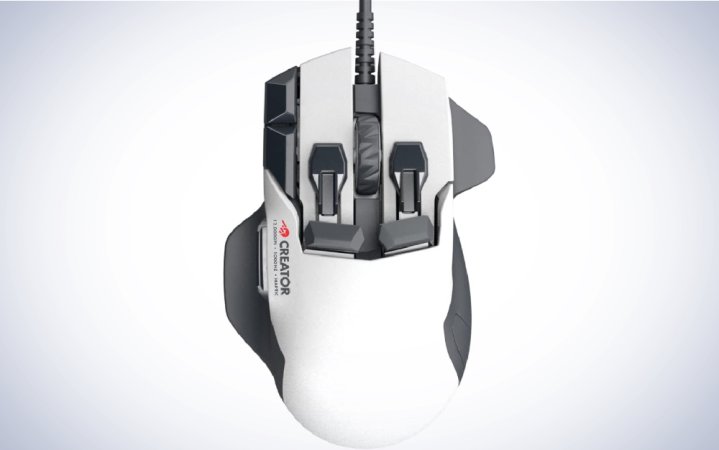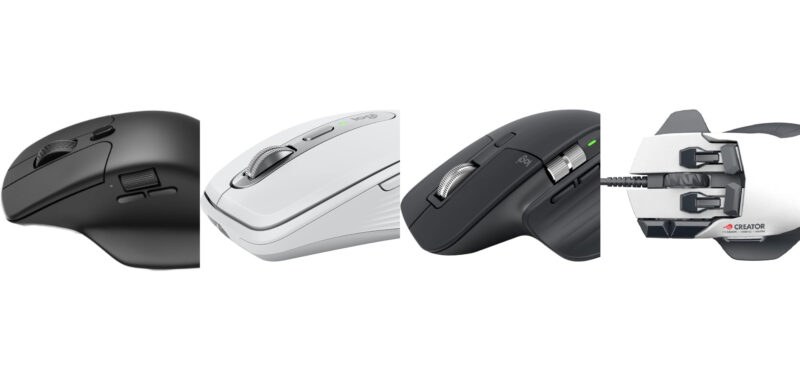We may earn revenue from the products available on this page and participate in affiliate programs. Learn more ›
If you work at a computer all day, you already know how important your mouse is to your productivity. Just as importantly, a great mouse and keyboard can enhance the quality of your workday, making it more pleasant and efficient. All too often, the mice provided by our employers are inexpensive and low-quality: functional but far from ideal. So, if you’re ready to improve the quality of your work life and enhance your productivity, upgrading to one of the best mice and best keyboards should be on your to-do list. There are lots to choose from—like our best overall, the Logitech MX Master 3S—so we’ve done the research to help you narrow down the very best choices available today. These are the best mice for work in 2024.
How we chose the best mice for work
I’ve been a PC fanatic for more than 20 years. I began my writing career covering computer games after having built dozens of PCs from my early teen years and well into adulthood. I’ve used and reviewed more mice than most people will use in a lifetime, publishing my work with leading publications like Tom’s Hardware, IGN, Popular Mechanics, and, of course, Popular Science. I know what makes a great mouse for different purposes, whether for work, gaming, content creation, or anything in between.
For this round-up, I began by considering the standout mice I’ve tested over the years to see which ones have maintained their top-tier status. I then cross-referenced my thoughts with critical reviews and composed a list of other popular picks. Ultimately, I settled on four mice that I’ve used personally and one that comes highly recommended from an especially esteemed ergonomic peripherals company (the Kinesis DXT Mouse 3). I would recommend these mice to my best friends; they accomplish their goals and push beyond the limits of what you would expect. They are the best of the best.
The best mice for work: Reviews & Recommendations
With all of that feedback in mind, you’re ready to find the right mouse for your workday. Whether you’re looking for the perfect productivity present for yourself or others, these are the best picks of the year so far.
Best overall: Logitech MX Master 3S

See It
Why it made the cut: Well-rounded, feature-rich, and comfortable, the MX Master 3S is the quintessential “work mouse.”
Specs
- Price: $99.99
- Button count: 7
- Sensor/DPI: Darkfield high-precision optical sensor, 8,000 DPI
- Polling rate: 125 Hz
- Weight: 141g
- Battery Life: Up to 70 days
- Software: Logitech Options+
Pros
- Logitech Options+ software offers advanced features
- Multi-system support
- Dual scroll wheels, including MagSpeed on the main dial
Cons
- Low polling rate
- Large size and heavy weight can feel bulky
Search far and wide, and you’ll be hard-pressed to find a productivity mouse more highly recommended or better suited to the task than the Logitech MX Master 3S. This mouse has a little bit of everything and includes a software suite that expands its functionality in surprising ways. It’s ergonomically designed to avoid unnecessary stress on your wrists, includes some of the best-feeling buttons in the business, and includes neat extras like rapid MagSpeed scrolling on the middle mouse wheel and a second thumb wheel for horizontal scrolling—or any other function navigation, you can set within the Logitech Options+ software.
It’s certainly a feature-rich mouse, but that’s only part of the benefit. The other aspect is its excellent ergonomics. The mouse sits tall, promoting an angled palm grip that is very supportive. A lip extends from the left side to support your thumb. This proves to be quite important, not only for assisting in the glide of the mouse but also because you’ll frequently be using your thumb to adjust the side scroll wheel. While not great for gaming, it has a reassuring weight that is perfect for productivity work where precision is key and is the preferred peripheral of several MacBook users on staff.
Not only does it feel good in the hand (and it does, thanks to its mix of high-quality plastics and metal for the scroll wheels), but it has a feature set that can actually improve your productivity throughout the day. The Logitech Options+ software allows you to really take advantage of its advanced feature set. You can connect it to multiple machines at once and even copy and paste files between them using the software, so if you oscillate between the computers, you won’t need to spend time manually connecting to both machines. It also allows you to assign gesture controls so you can simply hold a button and simply swipe left, right, up, and down to complete different shortcuts.
The real star of the show, however, is Logitech’s MagSpeed scroll wheel. It’s akin to a fidget spinner for adults, and once you get used to it, it’s hard to go back to any mouse without it. If you work with long web pages or lengthy spreadsheets, it makes navigating those documents dramatically faster, but it also can be toggled for when you need precise line-by-line control.
Taken as a whole, the Logitech MX Master 3S may not be the cheapest mouse, but it is impressive in virtually every way, making it the premier choice for anyone looking for a pointer upgrade.
Best ergonomic: Kinesis DXT Mouse 3

Kinesis
See It
Why it made the cut: When ergonomics needs to come first, the Kinesis DXT Mouse 3 is the perfect choice.
Specs
- Price: $110
- Button count: 6
- Sensor/DPI: Optical (unnamed), 2,400 DPI
- Weight: 104g
- Connectivity: RF wireless
- Battery life: Up to one month
Pros
- Small and easy to grip
- Vertical design is perfect for avoiding unneeded stress on the wrist and arms
- Precise, pen-like control
Cons
- No Bluetooth
- Comparatively low sensitivity
Kinesis made its name by developing ergonomic office keyboards. With the DXT Mouse 3, it brings that expertise to the world of pointers. Unlike most computer mice, this mouse is entirely vertical, allowing your hand to remain in a proper position to avoid any undue stress over time. Its design also allows it to be used with your fingertips, which, when paired with its small footprint, can make it feel downright pen-like.
The DXT Mouse 3 certainly looks a little strange. Don’t be surprised if coworkers come and ask you about it. But because it’s such a simple device, it’s easy to learn and get used to. Before long, you’ll wonder why all mice don’t better match your body’s natural positioning. Its unique shape also makes it more versatile.
Because of the pen-like way you’ll grip it, the DXT Mouse 3 offers more precise control than traditional mice. This makes it an especially good fit if you do any kind of design work but don’t want to go all the way into a stylus and touchscreen setup. Programs like CAD drafting tools work wonderfully with it.
Though Kinesis makes a handful of gaming products, this isn’t one of them. The maximum DPI is only 2,400. This should be enough for most office productivity and creative applications, but it highlights that it is purpose-designed for professionals. Its lack of Bluetooth support indicates that it’s really designed to be used with a single machine. Swapping over to a second one is fairly easy, however, since it uses a simple and compact USB dongle.
It should come as no surprise that the company best known for its ergonomic keyboards in the office space delivers one of the best ergonomic mice, too. It’s not exactly the cheapest, but its unique design sets it apart from other vertical mice and makes it a more versatile tool for a wider range of users.
Best for Mac: Logitech MX Anywhere 3S for Mac

Logitech
See It
Why it made the cut: Offering most of the benefits of the Logitech MX Master 3S in a more portable form, it’s the perfect companion for your MacBook Pro.
Specs
- Price: $69.99
- Button count: 6
- Sensor/DPI: Darkfield high-precision optical sensor, 8,000 DPI
- Polling rate: 90Hz
- Weight: 99g
- Connectivity: Bluetooth, wired
- Battery life: Up to 70 days
- Software: Logitech Options+
Pros
- Native Mac compatibility
- Full Logitech Options+ suite
- Lightweight, portable, and stylish
Cons
- Loses some functionality from the MX Master 3S
If you’re an Apple user and would prefer to spend less than $100 on a new mouse, the Logitech MX Anywhere 3S for Mac is the perfect choice. It brings with it most of the functionality of the Logitech MX Master 3S in a smaller, more portable, Mac-friendly package. There’s little not to love about this mouse, short of the lack of a thumb wing and side scroll wheel, and it comes in around $30 less, making it a killer value.
Like the Logitech MX Master 3S, this mouse has the MagSpeed middle scroll wheel, the same excellent Darkfield optical sensor with a maximum sensitivity of 8,000 DPI, and outstanding battery life. It’s rated for up to 70 days of constant movement on a single charge. It loses the side scroll wheel, which is a bit of a bummer, but it manages to be only 70 percent of the weight of the larger Master 3S. Its thinner and more compact design also makes it easier to throw in a bag or backpack and take on the go.
You can count on the same excellent value-adding functionality of the Logitech Options+ software, too. This includes easily flowing between multiple devices (including copying and pasting files), gesture control, and Smart Actions. And no, you won’t need to plug it in just to charge it.
Logitech is a dominant force in the world of productivity mice. And both the MX Master 3S and MX Anywhere 3S make that exceptionally clear. If you’re a Mac user, this is the mouse to choose.
Best splurge: Swiftpoint Creator

Swiftpoint
See It
Why it made the cut: Advanced is an understatement for this mouse. It offers features and functionality no other mouse on the market does and is the perfect tool for creative professionals.
Specs
- Price: $189.98
- Button count: 15
- Sensor/DPI: PixArt PMW3360, 12K
- Polling rate: 1,000Hz
- Connectivity: Wired (USB Type-C)
- Weight: 117g
- Software: Swiftpoint Software
Pros
- Incredibly versatile
- Unique “deep click” buttons
- Premade profiles for creative applications
Cons
When price is no object, the Swiftpoint Creator becomes one of the most compelling objects readily available on the market. This mouse offers a deep world of customization potential, featuring up to 15 buttons and advanced features like pressure sensitivity and haptic feedback. Not interested in that? It also comes with a wide range of preset profiles and actions to match different applications, so you can set it and forget it to get mousing fast.
The Creator offers buttons on top of buttons, on top of buttons—and I mean that literally. In addition to your standard left- and right-click buttons, you have two depth-sensitive buttons positioned midway back on top, with two more buttons behind that. This combination puts six buttons directly beneath your two fingers, but it doesn’t end there. Two additional buttons are positioned just to the side of the left click, and there’s an up-and-down paddle on the left thumb.
That’s a lot of buttons—with the scroll wheel included, it brings the total to 13—but the two middle left and right clicks are also pressure-sensitive. A light click can send one action, while a “Deep Click” sends another. It’s enough to be a little overwhelming, but Swiftpoint is prepared for that.
All of these inputs can be configured using Swiftpoint software. If it were a blank slate, you could spend hours programming it to match your workflow, but it comes ready to use with premade profiles for a range of different applications, like the Adobe suite, the Canva app, Microsoft Office, and more.
There’s a steep learning curve here (I had to print out my presets until I had them memorized), but once you’ve committed everything to memory and customized it to meet your personal workflow, your productivity can explode. You’ll spend less time clicking around and have more control at your fingertips, saving you time and making you money.
The Swiftpoint Creator is an incredibly capable mouse, but to keep all of these advanced features functioning properly (and, I presume, not rapidly chewing through battery life), the company decided to stick to a wired-only connection. You’ll need to contend with a cable, but battery life and recharges will never be a concern.
The Swiftpoint Creator won’t be for everyone, but it’s a uniquely powerful mouse that can completely transform how you work.
Best value: Keychron M6

Keychron
See It
Why it made the cut: Taking a proven design, lowering the price, and increasing the specs, the Keychron M6 is the definition of value.
Specs
- Price: $54.99
- Button count: 6
- Sensor/DPI: PixArt PMW3395 Optical, 26K DPI
- Polling rate: 1,000Hz
- Weight: 78g
- Connectivity: 2.4GHz, Bluetooth, wired
- Battery life: Up to 80 hours
- Software: Keychron Engine
Pros
- Proven design with great ergonomics and features
- Excellent specs make it a good choice for gaming
- Versatile connectivity
Cons
- Lacks additional software features for productivity
Looking for a great ergonomic mouse that won’t break the bank? The Keychron M6 is exactly that and more. Taking heavy inspiration from the Logitech MX Master 3S, this mouse offers many of the same benefits while also improving the specs to a significant degree. In fact, its speed and accuracy make it a competitive choice for gaming as well as work. It’s a versatile little device with few trade-offs.
Look at it from afar, and you might just think this is the Logitech MX Master 3S. The shape, contour, and button layout are almost exactly the same, so you can count on the same ergonomic benefits. Inside, however, it uses a PixArt 3395 optical sensor with a maximum sensitivity of 26,000 DPI. It also offers a 1,000-hertz polling rate so that it will report its location back to your computer 1,000 times every second. It’s also significantly lighter, at only 78 grams. It connects with your choice of Bluetooth, rapid 2.4GHz, or using a standard USB Type-C cable, and even offers more battery life with a maximum runtime of up to 80 hours.
So why wasn’t this my pick for the best mouse for work overall? Well, its software is a bit more limited. It doesn’t offer the same easy flow between multiple machines, and there’s no transferring files with it either. Gesture control and Smart Actions are both exclusive to Logitech.
Keychron software does allow you to control different parameters, like its sensitivity and liftoff distance, and even record macros if your workflow calls for it. It also has a free-flowing scroll wheel, though it lacks the same satisfying momentum of the MX Master and MX Anywhere. Still, it’s a great alternative that comes in at a fraction of the cost and, in my opinion, feels a bit better to use thanks to its lower weight. While the MX Master 3S is purely for office work and creative applications, the Keychron M6 works well for just about anything you would like to do on your PC, including gaming, art, and everything in between. There’s even a 4,000Hz version if you’re a dedicated gamer and want to maximize its responsiveness.
Simply put, this mouse is a steal. At its current price, it is a standout value and offers a satisfying experience across the board.
What to consider when buying one of the best mice for work
Browsing Amazon for productivity mice quickly demonstrates how wide the market has become. There are literally hundreds to choose from. I’ll break down the best picks in the next section, but to help you on your shopping journey, these are the most important things to consider.
Shape, size, and ergonomics
Mice come in many different shapes, sizes, and weights. These directly impact how the mice feel to use. While you don’t need to worry about this quite so much as with gaming mice, it’s important to consider how you tend to hold your mouse. If you tend to rest your palm behind its buttons, a larger, more contoured mouse will most likely feel comfortable and supportive. If you instead hold the mouse with your fingertips or with a claw-like shape, a smaller, slimmer mouse is a better choice.
Another thing to consider is whether the mouse has any kind of lip to support your pinky or thumb. These small finger shelves can look a little strange at first but offer better support and glide as you slide the mouse back and forth.
The size and shape of a mouse culminate in its ergonomics. To prevent repetitive stress injuries (RSIs), select a mouse that supports your preferred grip type and promotes proper hand positioning. To get an idea of how well a mouse will perform, begin by dropping your arms to your sides and letting them hang naturally. Raise your mousing hand in front of you without changing its position. This is the most natural position for your hand, and though most mice won’t offer exactly this positioning, the best picks allow you to keep your hand slightly angled to promote circulation and prevent muscle strain.
Sensor and DPI
A mouse sensor is best thought of as a small camera that tracks its movement across your desk. This small component comes in either laser or optical forms. Optical sensors tend to be more common, but it’s possible that you may encounter laser sensors as you’re shopping. The biggest difference is that older optical sensors sometimes had trouble tracking on transparent surfaces like glass. This remains the case with very affordable mice, but most in the mid-range and higher range no longer have this challenge.
Unlike gaming mice, which tend to indicate their performance based on their sensitivity (Dots-Per-Inch or DPI), productivity mice do not need to reach for astronomically high sensitivities. Since you’ll mainly be clicking through documents, navigating websites, or perhaps working in creative applications, you shouldn’t concern yourself much with finding the highest DPI possible. Many people find DPI settings between 1,000 and 3,200 to be the most comfortable. With that in mind, it is also wise not to opt for a mouse with a very limited DPI, as this can indicate a lower-quality mouse overall. In general, it’s wise not to opt for anything less than 4,000 DPI, though there are some exceptions, like the Kinesis DXT Mouse 3 I recommend in this list.
Wired or wireless?
Productivity mice come either wired or wireless. If they are wireless, they will connect over Bluetooth or 2.4GHz. Even though different brands frequently refer to the latter connection with their own branded names (such as Logitech’s Lightspeed Wireless), you can usually tell this connection method because the mouse will come with a separate USB dongle. 2.4GHz wireless is much faster than Bluetooth but is usually best suited for gaming. There is little benefit to using 2.4GHz for productivity, so you can be confident knowing that this feature isn’t a necessity if you’d like to save a few dollars. 2.4GHz is also more taxing on the battery and leads to more frequent recharges.
Ultimately, this comes down to personal preference, but it can be very convenient not to have additional wires cluttering your desk. If you do choose to go wireless, you’ll need to keep an eye on battery life. Thankfully, most Bluetooth productivity mice are capable of working for multiple weeks with rechargeable batteries and months with disposables.
Another important consideration if you opt for a wireless mouse is whether or not it has RGB backlighting. RGB is notoriously power-hungry and can dramatically reduce battery life, often cutting it in half. Manufacturers often obfuscate this by quoting the best-case scenario battery life with all lighting disabled. If you like colored lighting, that trade-off should be considered.
Additional features
Finally, with so many options to choose from, you should always consider what additional features the mouse brings to the table. For example, Logitech offers its Options+ software, which allows you to easily use the mouse across different systems, add gesture control, and program smart actions to automate small elements of your workday.
There are also hardware features to keep an eye out for. Returning to Logitech, it has pioneered Its own MagSpeed scroll wheel, which allows the scroll to spin freely up to 1,000 lines per second or ratchet down for more precise control. Other brands offer their own unique features, like additional buttons or alternate layouts, to enhance their usefulness in certain situations.
There are so many options that you shouldn’t be afraid to shop around until you find Features and functionality that are especially appealing to you.
FAQs
While this sensitivity would be comfortable for many people, depending on the resolution of your computer monitor and your own preferences for mouse speed, it may feel sluggish. These days, a 1,000 DPI mouse would be considered extremely low and any mouse listing this as its maximum resolution should raise red flags as to its overall quality. If you prefer this level of sensitivity, nearly all mice offer customizable DPI settings within their respective softwares or similar settings using built-in DPI buttons.
Gaming mice can certainly be good for work, but it’s important to keep in mind that they are often priced more highly than pure productivity mice, and they’re designed with different goals in mind. Gaming mice often feature high resolutions and maximum speeds, as well as top-of-the-line optical sensors. Very commonly, they feature aggressive designs and bright RGB lighting. These all come at a cost, and it’s not just financial. Wireless gaming mice often have shorter battery life due to their faster connections and demanding components.
A classic question with a classic answer: The types of mouse that work best for you depend entirely on your preferences. Thankfully, the decision is less complicated than it was in the past. For many years, there was legitimate concern over the responsiveness of wireless mice as their batteries weakened. By and large, that is no longer the case. Due to advancements in battery technology, wireless mice and other peripherals maintain their performance throughout their use-time. A wireless mouse does demand recharges or battery swaps, however, so it does demand one more thing to keep in mind.
Final thoughts on the best mice for work
While a mouse might seem like a small piece of your workday, it’s one you’ll notice every time you use your PC. A great mouse enhances your computing experience, improving the quality of your work day. Paired with a great keyboard, it’s one of the best investments you can make, and you’ll be grateful you took the time to achieve it.

